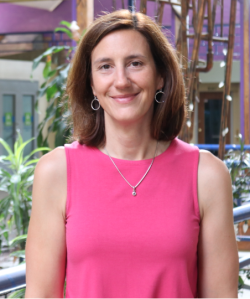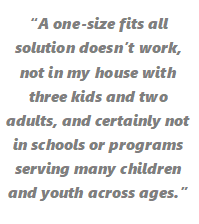A Note on Transitions - From Whole Child Connection Director, Elizabeth Devaney

I’ve been thinking a lot these days about the transition from childhood to adolescence. I have a 7th grader who is closing in on 13, and together we are navigating that delicate balance between parental control over what she is doing and experiencing and her own need to explore, be independent, and learn from mistakes. Sure I understood that kids get older and have to become more self-sufficient, but I hadn’t really thought about what that would look like from a parenting perspective, especially with younger children in the house who still need a little more guidance.
Take screen time, for example. One hour of screen time a day works well as a rule for my 6 year old. When I tell him “time’s up” he turns his device off with only minor complaints. With my 10 year old it is getting a little more complicated. Does gaming count? How about if she wants to text a friend for 5 minutes? What if she wants to just look something up quickly? But still, with a few easy exceptions, the rules pretty much apply. That said, at age 13, all bets are off. What to do about Face Time calls which can go on for hours between tween girls? How do you quantify time spent on Instagram or texting to coordinate sleepovers? And there is certainly no feasible way to count screen time when the phone is with her all the time and her parents are not. The “rules” of childhood don’t work anymore.
So I’ve been drawing on social and emotional skills (hers and definitely my own) as I navigate this new territory. Instead of talking about time limits, we talk more about the importance of understanding herself (she’s an introvert) and when she needs to step away to really recharge. We talk about sleep and how cell phones can mess with natural bio-rhythms and how reading a real live book can signal her body that it is time to go to bed. We talk about balancing physical activity, face-to-face human interaction, alone time and screen interactions. We cover how hard it can be to set your own limits in the face of highly addictive technology. For better or worse, we’re figuring it out together. She seems willing to at least engage in the conversation while my younger two are just happy to have clear rules and limits.

It gives me great respect for teachers, out-of-school program staff, and early care providers who are working with children at very different developmental levels. How does a school create effective social and emotional learning, physical education, recess and cafeteria policies, when students need such different things? How do you create an environment that works for kindergarteners and 5th graders at the same time? What does it mean to address the “whole child” when there are 500 whole children in a building? I’ve seen glimpses of how this looks at the schools and programs we work with. Some schools use a tag line (for example “being our best selves, doing our best work”) to set the tone for the whole building and then let each grade level craft what that means for their students. Many after school programs across the Rochester region use a common quality improvement tool to observe staff on specific instructional practices that promote positive youth development and they have coaches who help program staff figure out what that practice might look like for their specific youth participants (for example, 'choice' for 6 year olds might be choosing between three discreet activities while 'choice' for high school students might be identifying, designing, and carrying out a community service project).
In other words, a one-size fits all solution doesn’t work, not in my house with three kids and two adults, and certainly not in schools or programs serving many children and youth across ages. However, it is possible to have school or program-wide approaches that work for everyone. Taking a whole child approach by creating a safe and caring environment, fostering healthy relationships, teaching skills and competencies, and building healthy habits is universal. It is the approach we take with each grade level and with each individual child that can vary. It only took me 12 years to figure that out as a parent, but now I'm more prepared for what's coming next with all three of my kids.
